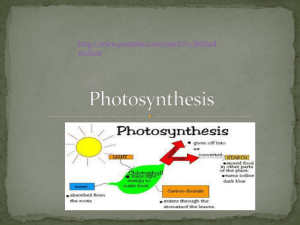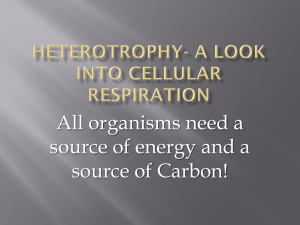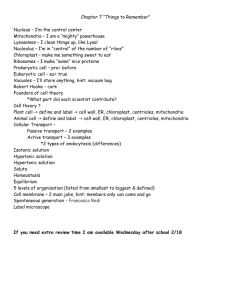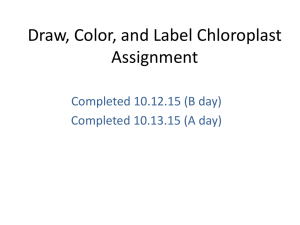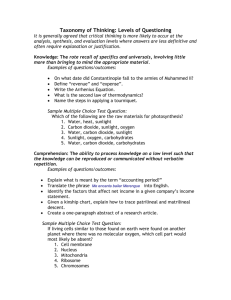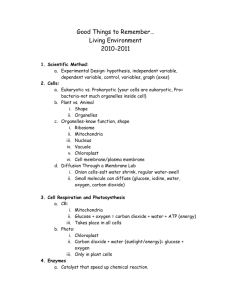Photosynthesis and Cellular Respiration
advertisement
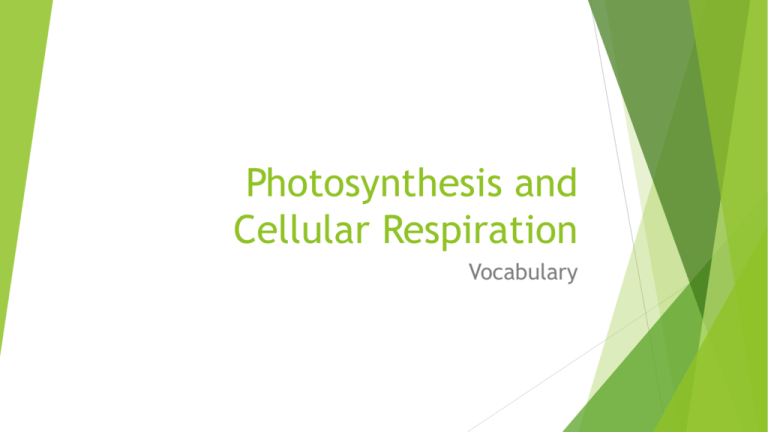
Photosynthesis and Cellular Respiration Vocabulary ATP – Adenosine Triphosphate Cellular Energy ADP – Adenosine Diphosphate Expended (used up) cellular energy; waiting to be recharged. Chemosynthesis Using chemicals (instead of light) to make food/energy. Photosynthesis Carbon dioxide (CO2), water (H2O), and sunlight make glucose (C6H12O6) and oxygen (O2) Sunlight CO2 + H2O C6H12O6 + O2 Chloroplast Organelle where photosynthesis occurs Chlorophyll Green pigment in chloroplasts that absorbs sunlight Stroma Fluid outside the thylakoid where lightindependent reaction occurs Granum (grana) Stacks of thylakoids in the chloroplast Thylakoid Disk-like structure in a chloroplast where light-dependent reaction occurs. Contains chlorophyll Stomata Small pores on the bottom of leaves that allow CO2 in and H20 & O2 out. Light-dependent reaction Sunlight & water enter, oxygen & energy exit Sunlight is used to break apart water to make energy for the light independent reaction and oxygen as a waste product. Takes place in the thylakoid of the chloroplast. Light-independent reaction Energy & carbon dioxide enter, glucose exits Uses the energy from the light-dependent reaction and carbon dioxide to make glucose. Takes place in the stroma of the chloroplast. Calvin Cycle Another name for the light-independent reaction. Carbon dioxide and energy are used to make glucose in the stroma of the chloroplast Cellular Respiration Cells make ATP by breaking down glucose. Glycolysis Anaerobic process where glucose is broken down to pyruvate Takes place in the cytoplasm Cytoplasm Where glycolysis happens Mitochondria Organelle where cellular respiration occurs. Krebs Cycle Breaks down pyruvate into carbon dioxide and energy. Takes place in the matrix Also called the Citric Acid Cycle Citric Acid Cycle Another name for the Krebs Cycle Mitochondrial Matrix The space inside the mitochondria where the Krebs Cycle occurs Pyruvate A 3-carbon molecule made during glycolysis and used in the Krebs cycle Used in both aerobic and anaerobic respiration Electron Transport Chain (ETC) Occurs in the cristae of the mitochondria Movement of electrons to make ATP Mitochondrial Cristae The inner membrane of the mitochondria where the ETC (electron transport chain) happens. Aerobic With oxygen Krebs and ETC Anaerobic Without oxygen Glycolysis and Fermentation Fermentation The breakdown of glucose without the use of oxygen Can produce lactic acid or alcohol. Lactic Acid Created during fermentation & causes burning feeling in muscles Reactants Left side of the arrow; Materials that go “into” a reaction and are changed Products Right side of the arrow; Materials that are created & come “out” of a reaction Xylem Vascular tissue of the plant that carries water Phloem Vascular tissue of the plant that carries food.
